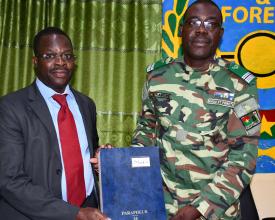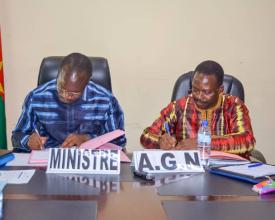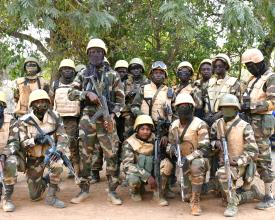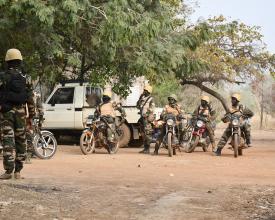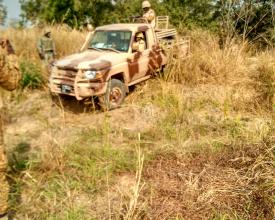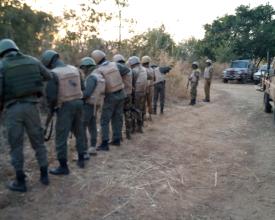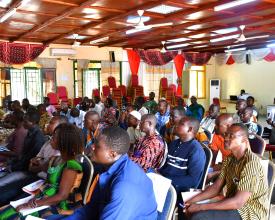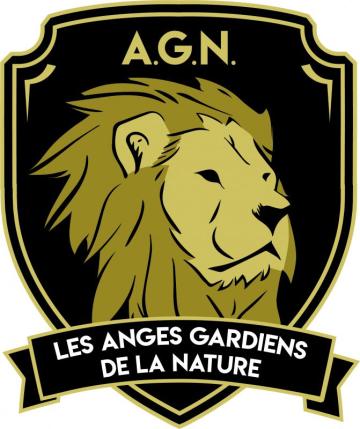
Project to consolidate the fight against poaching (LAB) in the W-Arly-Pendjari (WAP Burkina) and Po-Nazinga-Sissili (PoNaSi) complexes.
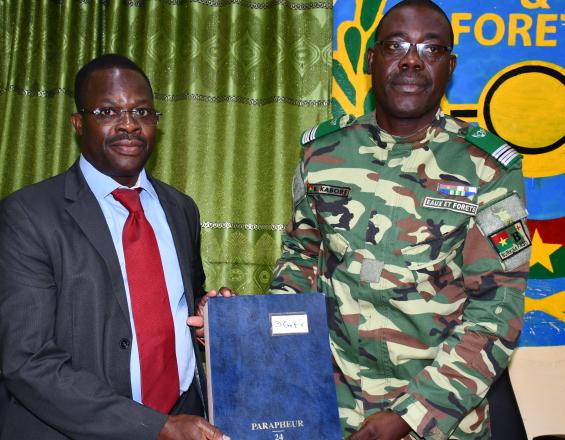
The 355,000 ha PONASI landscape, one of the last remaining continuums in the West African sub-region, is subject to a number of threats. This has led a number of players to seek solutions, including the "Projet d'appui à la consolidation de la LAB dans le complexe W-Arly-PoNaSi" (Support project for the consolidation of the LAB in the W-Arly-PoNaSi complex) run by "Les Anges Gardiens de la Nature" (Guardian Angels of Nature).
This project aims to contribute to
- strengthening and professionalizing the fight against poaching
- the stability of the PONASI and WAP landscapes.
Faced with the attempted occupation of protected areas by armed terrorist groups, it was no longer possible to carry out anti-poaching activities (AML) in the traditional way, using only forestry services and eco-guards. It was necessary to restructure the AML strategy and apply the principle of a global approach involving the military, Water and Forests, eco-guards and local communities. The aim was to pool efforts, techniques and resources for AML activities in protected areas.
Context
Challenges addressed
- Subsistence (local) and commercial (cross-border) poaching,
- Livestock grazing,
- The rapid advance of the agricultural front,
- uncontrolled bush fires,
- Land grabbing by private agricultural investors (leading to uncontrolled land clearing).
- pollution of natural resources through the use of pesticides and herbicides
- uncontrolled gold panning using cyanide and mercury.
- Safety issues
- Weak anti-poaching resources
Location
Process
Summary of the process
Block 1: Strong involvement and collaboration with government services to implement a joint anti-poaching approach
Once the mission has been defined, it needs to be validated by the state services (forestry and defense services) and the establishment of staffing tables and allocations, as well as the provision of material and logistical resources.
Block 2: Training
Now that the men in the units have been grouped together and the resources assembled, it's time to train the men, as they need to be able to use the same elements to gradually build up their capacity, with experience in the field and new training courses. Each entity involved in operations is strengthened.
Block 3: Community collaboration and involvement
Communities contribute to the success of operations to secure and protect Protected Areas by providing the project with young people recruited as eco-guards and tracker-guides.
Building Blocks
Strong involvement and collaboration with government services in the implementation of a joint anti-poaching ap-proach.
Throughout the project, the involvement and collaboration of the administrative, military and paramilitary authorities representing the State has enabled the launch of large-scale joint anti-poaching operations capable of dissuading any desire to occupy the Protected Areas, given the level of insecurity.
This strong involvement of the State has enabled the various local security actors (FDS) to come together around the same table, bringing them to federate their efforts to achieve common goals.
The army's full collaboration in these kinds of activities is essential, and was a reality in the context of this project, enabling all members of the mixed units to be equipped with protective gear, weapons and ammunition.
Enabling factors
- Bringing together the various players in local security (FDS) around the same table,
- Logistics and pooling of resources (financial, material and technical),
- Coordination of activities
Lesson learned
The logic of a global approach combining the forces available is adapted to the specific terrain of Protected Areas, enabling the reconquest and complete control of these protected areas, which are still too often inaccessible, a necessary condition for securing the wider landscape.
Men's training
Training was a key factor in the success of anti-poaching operations.
The different elements did not have the same working procedures, the same work rhythm or the same rigor.
The men all received technical and tactical training, as well as knowledge of wildlife and the forest environment. This training was highly beneficial, enabling the men to reinforce their knowledge in various fields (forest combat, combat first aid, IST, ISTC, navigation, operational motorcycle driving, camp defense, logistical and operational mission preparation, RETEX, etc.). A total of 10 operational training modules are delivered each time a force projection is planned.
The capacity-building achieved through the operations supported by the project should be maintained for future operations, as it fosters close collaboration and a climate of trust between the various units deployed.
Enabling factors
- The same training for all planned units,
- Better coordination,
Lesson learned
When the components of mixed units receive the same training, everyone knows their role better, and command and action in the field are more effective.
Community collaboration and involvement
Collaboration with the local population has been a major factor in the success of anti-poaching operations, and must be maintained in order to strengthen confidence and build up the sources of intelligence essential for well-targeted actions in the Protected Areas (PA).
The objective of restoring public confidence in the security and defense forces (FDS) and creating a climate of serenity was 100% achieved under the project. The mixed units not only had access to eco-guards from the communities, but were also able to interact with the local population, exchanging ideas and restoring their confidence. This contact between the mixed units and the local populations was a unique opportunity that should be repeated.
Contact cells (intelligence cells) from the communities were also set up, with the overall mission of infiltrating the area covered by the PONASI complex in order to detect any suspicious poaching or criminal activity, and to quickly pass on information, process and analyze it, and initiate action or have it initiated.
Enabling factors
- Community participation in anti-poaching operations with village-based eco-guards,
- Community participation in information-gathering operations through village-based community intelligence networks.
Lesson learned
Ongoing inter-action between mixed anti-poaching units and local populations ensures better coverage of the landscape and faster results in protecting and securing Protected Areas.
Impacts
The PONASI BIOPAMA and EU project has made it possible to: clean up the PONASI complex and reverse the degradation of its biodiversity caused by illegal exploitation and occupation.
As a result
- Improved knowledge of the terrain by anti-poaching personnel (LAB) and the defence and security forces (FDS).
Army units were unfamiliar with the terrain of the PONASI complex and with appropriate forest behavior. The Kaboré Tambi Park (PNKT) area was little known, even by Eco guards and Eaux et Forêts agents.
- Improved collaboration and a climate of trust between the various units/forces deployed
The men were all given technical and tactical training, as well as knowledge of wildlife and the forest environment. This training was highly beneficial, enabling the men to strengthen their knowledge in the various fields required for anti-poaching operations, and to get to know each other better.
- A resumption ofeconomic activity in the PONASI landscape
After the terrorist attacks in 2019, economic activities in the PONASI area came to a halt, but resumed as soon as the first operations were completed. People are feeling confident again.
Beneficiaries
The beneficiaries are the inhabitants of the 4 pilot communes in the Centre-West and Centre-South of Burkina Faso. The institutional beneficiaries are PONASI landscape managers, executive staff, local authorities and ecoguards.
Sustainable Development Goals
Story
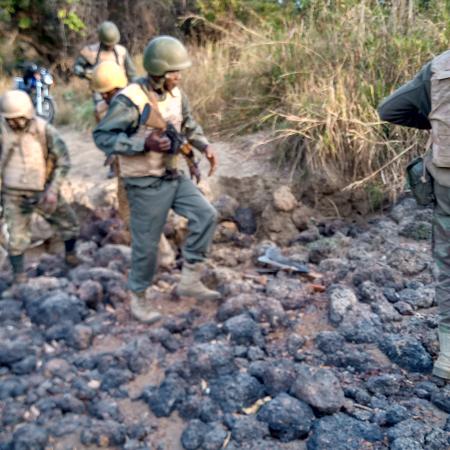
Poaching and deforestation are the greatest threat to many of Africa's animal and plant species.
Criminal poaching can generate huge black-market revenues worth more than a hundred times the average income of villagers living around protected areas.
In BURKINA FASO, to counter criminal poaching, we decided to act at several levels and on the causes - training staff, organizing patrols, campaigning for tougher measures to combat the illegal trade in animal species, helping communities.
A pilot experiment was therefore launched in and around the PONASI complex. This experiment, which involved recruiting local children and training them as ecoguards to monitor the Protected Areas, was opposed by all the local villages, which saw the ecoguard as someone who would prevent them from taking advantage of the bush.
But in 2019, the "classic" pressures have been compounded by the security problems the whole country has been facing since 2015.
The project area recorded its first major attacks in July 2019, which continued to multiply throughout August and September 2019, causing several deaths, including three gendarmes and several civilians.
With a view to helping secure the complex and stabilize security in the project area, the AGN association has launched a number of activities with all the defense and security forces, including:
- Setting up a sensor-based intelligence unit to gather information on major events,
- The organization of anti-poaching and clearance operations throughout the PONASI complex.
Our mission will therefore evolve. It's no longer just a matter of keeping an eye on people who come to kill game or cut down trees; it's becoming a national security issue.
The eco-guards have thus become the first barrier force protecting the population, enabling a return to peace and quiet and a revival of economic activity after these series of terrorist attacks.
Since these interventions in 2019, a sense of complicity has developed between the people of the PONASI landscape and the eco-guards, who are now seen as saviors.
